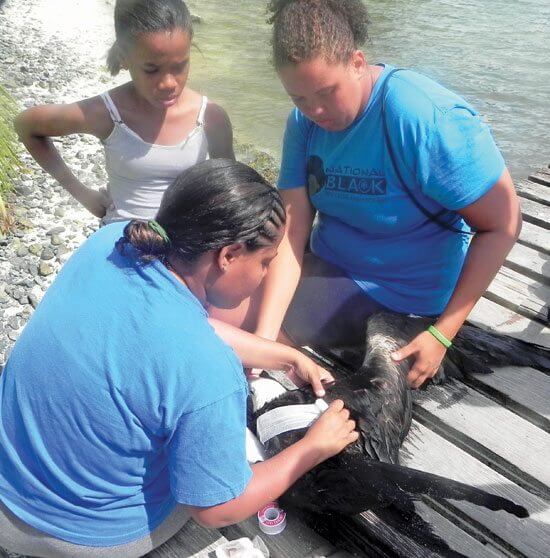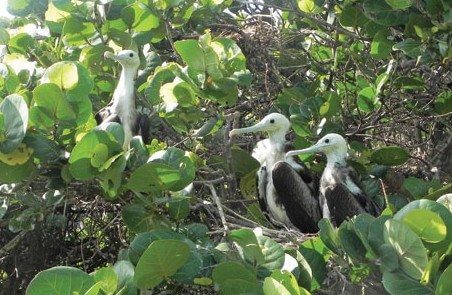On a remote windward shore in the British Virgin Islands, 500-600 pairs of Magnificent Frigatebirds (Fregata magnificens) nest together, helping to form the third largest seabird colony in the Caribbean and the only frigatebird colony within two hundred miles. One of the most iconic of Virgin Islands seabirds, these scissor-tailed animals, known locally as ‘Man O’ War’, can be seen soaring effortlessly above the sea, performing aeronautic acrobatic stunts and swooping about with great agility and speed.

With an impressive seven-foot wingspan, these nimble birds are sometimes known to steal food from other unsuspecting birds in mid-flight, a type of animal behavior known as kleptoparasitism. However, unique nesting habits and biology compound the situation for the Magnificent Frigatebird. Firstly, frigatebirds’ habits of eating ‘on the wing’ put them at a heightened risk of falling victim to lures skimming along the surface of the water. In the modern world, this skill may also help contribute to their demise, as it is sometimes a brightly colored plastic cap or artificial fishing lure which captures their attention. From high in the sky, the frigatebird plummets, racing skillfully at this artificial (and potentially deadly) catch.
Much to the dismay of bird and fisherman, the scene that ensues after a Man O’ War has been hooked by a fishing lure is often one of panic and confusion, though it all started innocently enough. Many times visiting tourists, new to angling, are fearful that they are hurting the struggling bird and plead with captains to cut the line, while other fishermen may just be irritated by the seabird struggling on their hook. As a school of fish that first attracted the seabirds may swarm about below the boat, the fisherman struggles with his unwanted avian by-catch. Whatever the motivation, the end result is often the same: the line is cut. Bird and man are temporarily relieved as the bird struggles to fly away, trailing an invisible strand, sometimes several meters long, of clear monofilament line. It may be the end of the story for the fisherman, but it is not the end of the story for the bird.
Being hooked can cause strangulation or deforming injuries that will ultimately translate to malnutrition and starvation for any seabird. Unique nesting habits and biology compound the situation for the Magnificent Frigatebird, however. Firstly, Frigatebirds’ habits of eating ‘on the wing’ put them at a heightened risk of falling victim to lures skimming along the surface of the water. The colonial nesting habits of Magnificent Frigatebirds also increase the odds that a hooked bird will trail line back to the branches of the sea grape trees where the birds build their nests in close proximity to each other. There the invisible line will continue to ensnare other returning birds which, unable to break free from the deadly monofilament, will die.
Magnificent Frigatebirds have a lifespan of at least 35 years, and scientists believe that they may live up to 50 years of age, reaching sexual maturity at five to seven years. Frigatebirds only raise one egg at a time, and the young hatchling, naked and featherless, is extremely susceptible to mortality and can perish in the hot tropical sun or cold rainy conditions if left unattended. A frigatebird hatchling requires the attention of both parents, who work in shifts for the first few months to feed the young bird twice a day. Mothers will stay with their young until chicks are approximately a year old, despite the young bird being almost the size of the mother. Since the birds are constantly tending to their young, the absence or death of a parent may also lead to the death of young birds.
In summer 2011, Jost Van Dyke Preservation Society staff and volunteers visited the BVI’s Magnificent Frigatebird nesting colony to carry out surveys and found a gruesome sight under the seagrape trees. A total of 57 dead frigatebirds were found hanging from hooks and tangled in line. The group worked for hours removing monofilament line to prevent further deaths of the nesting birds.

WHAT YOU CAN DO IF YOU ACCIDENTALLY HOOK A SEABIRD WHILE FISHING
(Adapted from USVI Division of Fish & Wildlife)
• Do not cut the line!
• Slow the vessel down or stop.
• Slowly bring the vessel toward the bird. Do not pull on the leader; this could cause more damage to the bird.
• Lift the bird out of the water with a dip net if possible supporting the bird’s weight.
• Watch your eyes and control the beak to avoid injury to yourself; cover the bird’s head with a towel if necessary.
• Gently grasp the bill, being careful not to squeeze too tightly or the bird may suffocate.
• Locate the hook and push the barb to the outside of the skin.
• Cut the barb and then back the hook out.
• Ensure that all fishing line has been removed and the bird is otherwise uninjured before releasing.
• Frigatebirds are not waterproofed like most seabirds and may need some time to dry out before releasing.
If the bird is injured or you can not remove the hook safely, bring the bird to a local veterinarian or to DPNR/Division of Fish and Wildlife in Red Hook, St. Thomas or Mars Hill, on St. Croix if in the USVI.
Susan Zaluski lives in Great Harbour, Jost Van Dyke. She is the director of the Jost Van Dyke Preservation Society, a non-profit agency dedicated to the preservation of the history, culture and natural environment of Jost Van Dyke.




